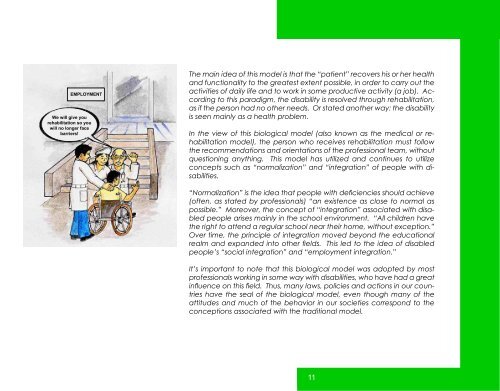in English - Handicap International
in English - Handicap International
in English - Handicap International
You also want an ePaper? Increase the reach of your titles
YUMPU automatically turns print PDFs into web optimized ePapers that Google loves.
EMPLOYMENT<br />
We will give you<br />
rehabilitation so you<br />
will no longer face<br />
barriers!<br />
The ma<strong>in</strong> idea of this model is that the “patient” recovers his or her health<br />
and functionality to the greatest extent possible, <strong>in</strong> order to carry out the<br />
activities of daily life and to work <strong>in</strong> some productive activity (a job). Accord<strong>in</strong>g<br />
to this paradigm, the disability is resolved through rehabilitation,<br />
as if the person had no other needs. Or stated another way: the disability<br />
is seen ma<strong>in</strong>ly as a health problem.<br />
In the view of this biological model (also known as the medical or rehabilitation<br />
model), the person who receives rehabilitation must follow<br />
the recommendations and orientations of the professional team, without<br />
question<strong>in</strong>g anyth<strong>in</strong>g. This model has utilized and cont<strong>in</strong>ues to utilize<br />
concepts such as “normalization” and “<strong>in</strong>tegration” of people with disabilities.<br />
“Normalization” is the idea that people with deficiencies should achieve<br />
(often, as stated by professionals) “an existence as close to normal as<br />
possible.” Moreover, the concept of “<strong>in</strong>tegration” associated with disabled<br />
people arises ma<strong>in</strong>ly <strong>in</strong> the school environment. “All children have<br />
the right to attend a regular school near their home, without exception.”<br />
Over time, the pr<strong>in</strong>ciple of <strong>in</strong>tegration moved beyond the educational<br />
realm and expanded <strong>in</strong>to other fields. This led to the idea of disabled<br />
people’s “social <strong>in</strong>tegration” and “employment <strong>in</strong>tegration.”<br />
It’s important to note that this biological model was adopted by most<br />
professionals work<strong>in</strong>g <strong>in</strong> some way with disabilities, who have had a great<br />
<strong>in</strong>fluence on this field. Thus, many laws, policies and actions <strong>in</strong> our countries<br />
have the seal of the biological model, even though many of the<br />
attitudes and much of the behavior <strong>in</strong> our societies correspond to the<br />
conceptions associated with the traditional model.<br />
11

















